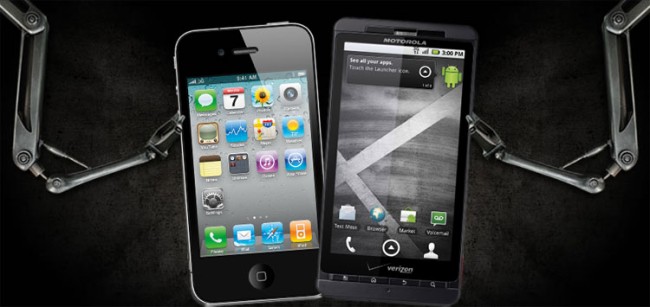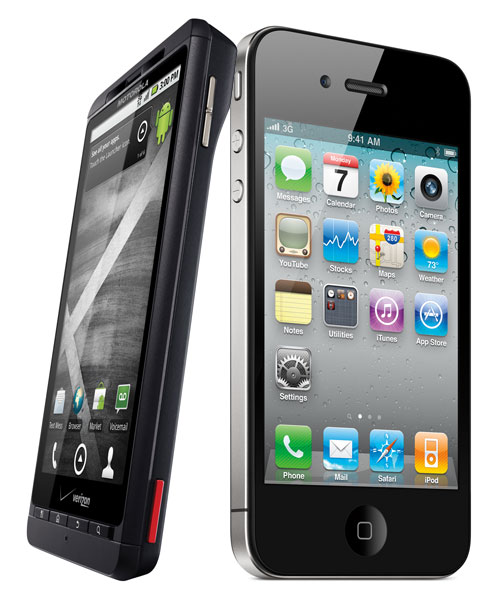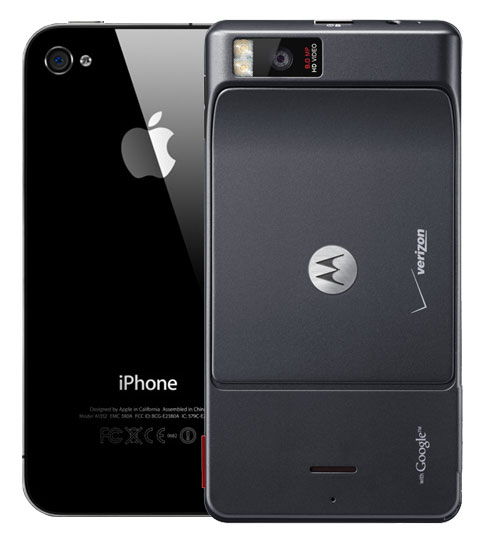
We break down Motorola’s Droid X and Apple’s iPhone 4, spec by spec, to see who really makes the hottest hardware.
The comparisons began before the phone even arrived. With Motorola setting a press conference date the day before the long-awaited iPhone 4 launch date, the stage was set for a battle royale, and Motorola delivered with a surprisingly fit challenger that came out swinging. Now that both contenders have weighed in, it’s only natural to run the stats side-by-side to see which phone prevails. After getting in a few hard-hitting jabs at Apple’s soft spots with the original Droid, does Motorola have what it takes to return to the ring and knock out the spunky new kid? Before you call your bookie, check out the numbers.
 Display
Display
Winner: Apple iPhone 4
As we noted on our comparison of the HTC EVO 4G and Apple iPhone 4, it’s really a matter of taste here, but we’re not above calling it. While Apple’s 3.5-inch display is smaller than the Droid X’s 4.3-incher, it’s also significantly higher in resolution. With 960 by 640 pixels on the iPhone 4 and only 854 by 480 on the Droid X, you’re looking at total pixel counts of 614,400 to 409,920 pixels. Why prioritize pixels? While a larger screen might strain the eyes less, higher resolution means sharper graphics, crisper text, and ultimately more screen real estate, which means less annoying scrolling on Web pages and long documents.
Processor
Winner: Draw
Despite predictions that the Droid X would use the same 1GHz Qualcomm Snapdragon processor found in most other top-tier Android phones these days, Motorola pulled an unexpected X-factor out of its hat on Wednesday by revealing that it would stick with the same Texas Instruments OMAP processors found in many other phones, including the old Droid, but ramp clock speed all the way up to 1GHz. Even attempting to get a rough feel for which might best which is difficult: No other phone has used a TI OMAP chip clocked at 1GHz so far, and although we know the iPhone 4 will use the same A4-family processor found in the iPad, we don’t know how fast it will be running, making a comparison, even on paper, worthless.
Storage
Winner: Motorola Droid X
Which is more important: Max capacity, or value? We’ve debated it on previous comparisons, but it doesn’t matter here, the Droid X wins in both regards. The $200 smartphone boasts 8GB of onboard memory plus a 16GB card preinstalled, giving it 24GB out of the box where the $200 iPhone 4 only has 16GB. And while the iPhone maxes out at 32GB, swapping the 16GB card in the Droid X out for a pricy 32GB card will put you up to a total of 40GB.
 Portability
Portability
Winner: Apple iPhone 4
There’s really no way a phone with a 4.3-inch screen can best a phone with a 3.5-inch screen in portability, but play along with us. The Droid X measures 5 inches long to Apple’s 4.5, 2.6 inches wide to Apple’s 2.3, and 0.4 inches thick to Apple’s 0.37 inches. None of those dimensions can be called egregious, but individually they add up to quite a bit more bulk. And more weight, too. The iPhone 4 weighs only 4.8 ounces, while the Droid X weighs 5.5.
Connectivity
Winner: Motorola Droid X
Unlike the vast disparity between the iPhone and HTC EVO 4G, the latter of which leverages a significantly faster wireless network, both the Droid X and iPhone 4 are stuck on 3G technology. But drag carriers into it, and Verizon clearly has the upper hand, with 3G coverage blotting out most of the U.S. where AT&T’s clusters around cities, and has become notoriously unreliable even where it does reach. Add to that the Droid X’s built-in ability to act as a Wi-fi hotspot for up to five other devices, just like the Evo, and you have a phone that clearly outmaneuvers the iPhone 4 when it comes to connectivity.
Taking local connectivity into account – where most phones don’t have much to distinguish themselves any more – the Droid X is also one of very few phones to include an HDMI output for throwing still shots and video from the phone up on the big screen.
Battery Life
Winner: Draw
Talk about a tough one to call. While the Droid X boasts eight hours of talk time to Apple’s seven, the iPhone 4 also gets 300 hours of standby compared to just 220 on the Droid X. We call that a wash. If the numbers actually hold true, the Chatty Cathys among us will be better served by the Droid X, while those who use their phones less frequently should find the iPhone still alive and kicking when the Droid X has been dead for over three days.
The fact that you can remove the battery on the Droid X does give it a slight edge here, but given how many people we know who carry spare, charged batteries to actually take advantage of this hypothetical advantage (zero), we’re not tempted to give it too much weight.
 Rear Camera
Rear Camera
Winner: Motorola Droid X
Let’s first concede that specs – especially megapixels – don’t always tell the story with cameras. But until we have both cameras in hand, that’s all we’ve got. And the Droid X wins by every account. Besides higher total resolution with 8 megapixels to Apple’s 5 megapixels, it has a dual-LED flash to Apple’s single-LED flash, and, perhaps most important of all, a real shutter button. While Apple fans will still have to tap the screen to shoot, sometimes blurring photos from the jostle in the process, Droid X owners will get a real shutter button.
Buttons aren’t always bad, Steve.
Videoconferencing
Winner: iPhone 4
The iPhone has a front-facing camera for videoconferencing, the Droid X doesn’t. It’s tempting to shove this into the same category as “camera,†but it’s really for a distinctly different purpose, and merely having a front-facing camera shouldn’t negate the fact that the Droid X has a better camera in the rear.
Overall Winner: iPhone 4
Save the boos and hisses for the comments section. In truth, these two are so varied in their strengths and weaknesses that it’s a draw based on specs alone. While the Apple iPhone 4 will be smaller, possess a more impressive screen and a knack at videoconferencing thanks to its front-facing camera, the Motorola Droid X guarantees a smoother ride on a larger 3G network, comes with more storage, more room to add storage, and what should be a superior rear-facing camera.
So it comes down to the intangibles. Android and iOS 4 both have their merits and demerits, but we think Apple has a better history of supporting older handsets with new software. A two-year-old iPhone 3G will still take advantage of the latest iOS4 software, but many much newer Android handsets haven’t made the leap to Android 2.1 yet – especially those with custom software like Motoblur, as the Droid has. The market for Apple accessories is also overflowing with options. The resale value of Apple hardware stays sky high – as evidenced by 3G S owners selling their old models for nearly what they paid for them. You can always find a friend with an Apple charger in a pinch. The list goes on and on.
Which should you buy? Stay tuned for full reviews of both phones, which should tell far more than specs and speculation ever can.
Did you know that if you subscribe to our website, you will receive email notifications whenever content changes or new content is added.
1. Enter your e-mail address below and click the Sign Me Up button.
2. You will receive an email asking you to confirm your intention of subscribing to our site.
3. Click the link in the email to confirm. That’s all there is to it! Note: if you wish to unsubscribe from our site, click the unsubscribe link at the bottom of the email you received.
Then indicate you no longer wish to receive our emails.
Thank You
Prisonbreakfreak.com Team